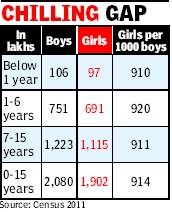Among children up to 15 years old, there are 1.8 crore fewer girls than boys — the sex ratio at 914 girls per 1,000 boys remaining the same as a decade ago. This is the chilling picture of the fate of girls emerging from age-wise data of India's population in 2011 released by census authorities on Friday.
The data gives population for each succeeding age year, and with each passing year, the number of girls surviving drops.
Usually, discrimination against girls is measured by the child sex ratio, that is, the difference in populations of the two sexes between zero and six years of age. Among infants who are less than a year old, boys outnumber girls by about 9.55 lakh. But by six years, the difference increases to nearly 7 million (69 lakh). This is also described as a sex ratio of about 919 girls per 1,000 boys.
The story doesn't end here. There is an appalling drop in the population of girls after that. The difference in the population of boys and girls aged seven to 15 years rises to nearly 11 million (1.1 crore). That's a sex ratio of 911 for this age group.
While female feticide is responsible for the skewed sex ratio at birth, the skew among living children is driven by gross neglect of the girl child, says Rajni Palriwala, professor of sociology at Delhi University. "Our field studies in several north Indian states in the mid-2000s showed discrimination against the girl child in distribution of food and in times of sickness. She is also given much more domestic work. It is a daughter aversion — in some cases deliberate and in others unconscious," she says.
Urban skew
Limited resources in families, as found in a very large number of poor families in India, sets up the context for this fatal discrimination. If resources are limited, sons get preferential treatment over daughters. But the Census 2011 data shows that the sex ratio in the 0-15 age group is 920 in rural areas, compared to just 900 in urban areas. This would imply that the discrimination against girls — which begins as sex-selective abortion in urban or more prosperous areas — continues even after birth.
A decade earlier, Census 2001 had shown a similar skew. In the 0-15 age group, the difference between the populations of boys and girls was some 17.3 million, at a lower population base. The sex ratio for this age group was 914, around the same as this time round. In other words, all the measures for special incentives for the girl child — conditional cash transfers, nutritional supplements, family incentives — have failed to make a dent in the prevailing mentality of son-preference and discrimination against girl children.
Girls face stiffer health challenges once they enter puberty because of regular loss of blood in menstruation. Any shortfall in nutrition in these years can dramatically damage her health, with anemia the most likely outcome. This compromises her health even further and makes her more susceptible to infections. In the Census 2011 data, this is starkly reflected: for the age group 14-18 years, the difference between the boys' and girls' populations adds up to a whopping 77 lakh.
Quite apart from changing the way people look at girls and women, even measures like an efficient public distribution system and an accessible health care system would go a long way in saving the girl child, Palriwala says. "If affordable food and healthcare are made available to families, it would save millions of girls from a slow death."
.jpg)

No comments:
Post a Comment